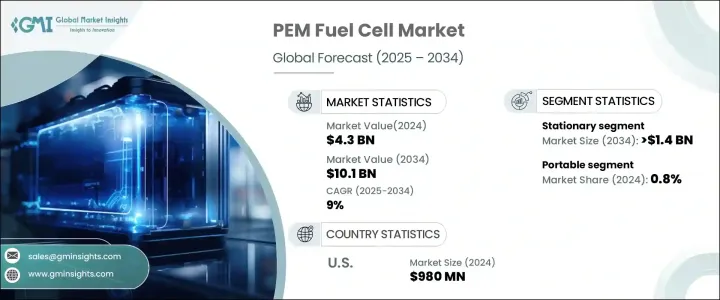
세계의 PEM 연료전지 시장은 2024년 43억 달러로 평가되었으며, 2025-2034년 연평균 복합 성장률(CAGR) 9%로 확대될 것으로 예상됩니다.
신재생에너지 중시의 고조 및 저배출로 고효율의 전원에 대한 수요 고조가 맞물려, 프로톤 교환막(PEM) 연료전지의 채용이 가속하고 있습니다. 이러한 연료전지는, 뛰어난 에너지 변환 효율, 환경 부하의 저감, 신속한 기동 시간 등, 몇개의 이점을 갖추고 있어, 다양한 용도에 이상적인 선택 사항이 되고 있습니다. 보다 깨끗하고 지속가능한 대체 에너지를 요구하며 전 세계 산업계에서 PEM 연료전지에 대한 관심이 고조되고 있습니다. 정부 및 민간단체는 이들 연료전지의 성능과 가격을 향상시키기 위해 연구개발(R&D)에 많은 투자를 하고 있어 시장 개척에 더욱 박차를 가하고 있습니다.

청정 에너지 솔루션으로의 전환은 발전, 운송 및 가전을 비롯한 여러 산업 분야에서 탁월합니다. 수송의 전동화는, 수소 연료전지 기술에 대한 대규모 투자의 원동력이 되고 있으며, PEM 연료전지는 제로 에미션차의 추진에 중요한 역할을 하고 있습니다. 미국, 독일, 중국, 일본 등, 카본 뉴트럴이라고 하는 야심적인 목표를 내거는 나라들은, 수소를 동력원으로 하는 솔루션의 전개를 가속하기 위한 정책 및 인센티브를 실시하고 있습니다. 더불어 수소 제조와 연료전지 인프라의 진보로 PEM 기술의 대규모 도입이 보다 현실적으로 되고 있습니다.
| 시장 범위 | |
|---|---|
| 시작 연도 | 2024년 |
| 예측 연도 | 2025-2034년 |
| 시작 금액 | 43억 달러 |
| 예측 금액 | 101억 달러 |
| CAGR | 9% |
PEM 연료전지 시장의 거치형 부문은 고효율, 저배출 가스, 비전화 지역에서의 신뢰성 높은 전력 공급 능력으로 2034년까지 14억 달러에 이를 것으로 예측됩니다. 기존 전력망에 대한 액세스가 한정되어 있는 산업 시설, 상업 빌딩, 원격지에서는, 지속 가능한 에너지 솔루션으로서 PEM 연료전지의 채용이 증가하고 있습니다. 환경에 미치는 영향을 최소화하면서 깨끗한 전력을 생성할 수 있는 연료전지는 백업 전원 시스템이나 분산형 에너지 발전에 적합한 선택지가 되고 있습니다. 기업 및 정부가 지속가능성 중시의 자세를 강화하는 가운데 거치형 PEM 연료전지의 수요는 급증해 업계 각사에 새로운 성장 기회를 가져올 것으로 예상됩니다.
휴대용 부문도 규모가 작지만 현저한 성장을 이루고 있습니다. 2024년에는 시장 점유율의 약 0.8%를 차지했습니다. 콤팩트하고 효율적이며 환경 친화적인 전원에 대한 수요가 높아지는 가운데 PEM 연료전지는 스마트폰, 노트북, 드론, 의료기기 등 소비자용 전자기기의 견인차 역할을 하고 있습니다. 이러한 연료전지의 효율, 안정성, 수명의 향상을 목표로 한 기술 혁신에 의해, 휴대용 용도로서의 매력이 높아지고 있습니다.
미국의 PEM 연료전지 시장은 2024년 9억 8,000만 달러를 창출해 북미가 24%의 큰 시장 점유율을 차지했습니다. 정부의 이니셔티브, 인센티브, 자금 제공 프로그램은 수소 기반 기술의 성장을 가속하는데 중요한 역할을 합니다. 배출 감축 목표 달성을 목표로 한 지원 정책에 따라 자동차에서 거치형 발전에 이르기까지 다양한 산업에서 연료전지의 도입이 가속화되고 있습니다. 현재 진행중인 수소 인프라 개발 및 민간 부문 투자 증가로 인해 PEM 연료전지 기술의 주요 시장인 북미 지위가 더욱 강화될 것으로 예상됩니다.
The Global PEM Fuel Cell Market reached USD 4.3 billion in 2024 and is expected to expand at a CAGR of 9% between 2025 and 2034. The growing emphasis on renewable energy, coupled with the rising demand for low-emission and high-efficiency power sources, is accelerating the adoption of proton exchange membrane (PEM) fuel cells. These fuel cells offer several advantages, including superior energy conversion efficiency, reduced environmental impact, and fast start-up times, making them an ideal choice for various applications. Industries worldwide are increasingly turning to PEM fuel cells as they seek cleaner and more sustainable energy alternatives. Governments and private entities are investing heavily in research and development (R&D) to enhance the performance and affordability of these fuel cells, further fueling market expansion.

The shift toward clean energy solutions is evident across multiple industries, including power generation, transportation, and consumer electronics. The electrification of transport is driving substantial investments in hydrogen fuel cell technology, with PEM fuel cells playing a critical role in advancing zero-emission vehicles. Countries with ambitious carbon neutrality goals, such as the United States, Germany, China, and Japan, are implementing policies and incentives to accelerate the deployment of hydrogen-powered solutions. Additionally, ongoing advancements in hydrogen production and fuel cell infrastructure are making PEM technology more viable for large-scale adoption.
| Market Scope | |
|---|---|
| Start Year | 2024 |
| Forecast Year | 2025-2034 |
| Start Value | $4.3 Billion |
| Forecast Value | $10.1 Billion |
| CAGR | 9% |
The stationary segment of the PEM fuel cell market is projected to reach USD 1.4 billion by 2034, driven by its high efficiency, low emissions, and ability to provide reliable power in off-grid locations. Industrial facilities, commercial buildings, and remote areas with limited access to traditional power grids are increasingly adopting PEM fuel cells as a sustainable energy solution. The ability of these fuel cells to generate clean electricity with minimal environmental impact makes them a preferred choice for backup power systems and distributed energy generation. As corporations and governments intensify their focus on sustainability, the demand for stationary PEM fuel cells is expected to surge, creating new growth opportunities for industry players.
The portable segment, although smaller in size, is experiencing notable growth as well. In 2024, it accounted for approximately 0.8% of the market share. With the rising demand for compact, efficient, and eco-friendly power sources, PEM fuel cells are gaining traction in consumer electronics, including smartphones, laptops, drones, and medical devices. Technological innovations aimed at enhancing the efficiency, stability, and longevity of these fuel cells are making them increasingly attractive for portable applications.
The United States PEM Fuel Cell Market generated USD 980 million in 2024, while North America captured a significant 24% market share. Government initiatives, incentives, and funding programs are playing a crucial role in fostering the growth of hydrogen-based technologies. Supportive policies aimed at achieving emission reduction targets are accelerating the deployment of fuel cells across multiple industries, from automotive to stationary power generation. The ongoing development of hydrogen infrastructure, combined with increasing private sector investments, is expected to further strengthen North America's position as a key market for PEM fuel cell technologies.